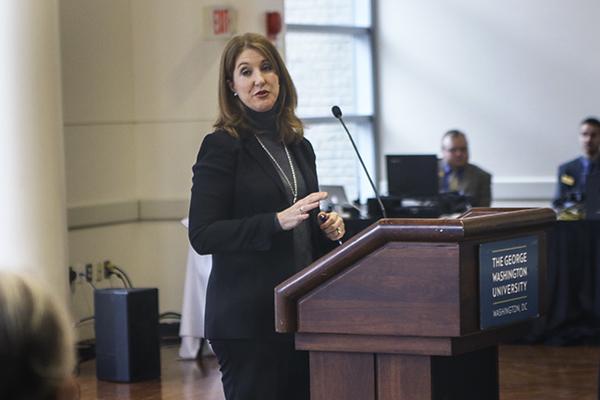Updated: Feb. 11, 2016 at 2:39 p.m.
The Council of Chairs is hoping to engage its inactive members this year through a series of new initiatives.
Laura Taddeucci Downs, the chair of the Council of Chairs, spoke to the Board of Trustees on Friday about how she will push to increase the group’s fundraising participation. Taddeucci Downs said she is considering giving council members term limits, moving some inactive members to emeritus status and enforcing minimum donation expectations.
The Council of Chairs advises the Board of Trustees, is made up of some of GW’s most active supporters and is sometimes considered the farm team for the Board of Trustees because about half of the current trustees started on the council. The group hopes to have 100 percent of its more than 570 members donate, and Taddeucci Downs said the council has seen 62 percent participation so far this fiscal year.
Last fiscal year, about 58 percent had donated by this time, Taddeucci Downs said. The Council of Chairs donated $89.6 million last fiscal year, and so far have given about $35 million, she said. And as GW nears the finish line on its $1 billion campaign, donations from council members could be key to attracting other gifts down the line.
Still, 10 percent of council members last year did not donate, which Taddeucci Downs said is a problem because council members – which include the Board of Trustees and the GW Alumni Association – can serve as a model for other potential donors. And as GW nears the finish line on its $1 billion campaign, donations from council members could be key to attracting other gifts down the line.
“They need to lead by example,” she said in an email.
To address that 10 percent, Taddeucci Downs proposed two solutions: moving disengaged council members to emeritus status, and introducing term limits of three years.
“We’ve had sometimes disengaged alumni and council members, and moving them off is awkward,” Taddeucci Downs said Friday. “Having a term limit is a nice, easy way to move people off if they become disengaged.”
Taddeucci Downs said that moving council members to emeritus, or honorary, status, and enforcing term limits will open spots for new alumni and members who are eager to contribute financially. Last year, she proposed adding young alumni to the council’s 18 advisory boards.
Taddeucci Downs is also pushing for councils to establish and enforce minimum donation amounts for their members. She suggests $1,000 for alumni six to 10 years after they complete their undergraduate degrees, $500 for alumni five years after graduation and $2,500 for other council members.
In addition to minimum donations, Taddeucci Downs said council members should be encouraged to follow the philosophy of donating “work, wealth and wisdom” through roles like connecting students and faculty with new opportunities.
Earlier this fall, Jeremy Gosbee, the president of the Alumni Association also called for a more engaged board. He said that 100 percent of Alumni Association board members donate each year, as is required in its bylaws, but has also encouraged members to meet with students or reach out directly with alumni to keep them connected.
“It’s not just about following the rules, it’s about people recognizing that this is a way to participate in what’s happening with the University. And by investing in the University themselves, they are helping make that case for other people to do the same,” Gosbee said. “We don’t find it’s a tough sell for people, they’re always excited to be involved.”
Rob Townes, the executive vice president of fundraising consulting firm Sinclair, Townes and Company, said the best way to keep members of a board engaged is to make expectations clear when they join.
“That should be delineated so people are clear from the get-go that this is just something that’s part and parcel of your responsibility as a leader,” Townes said. “Typically it’s 100 percent generous, if not sacrificial, participation that’s required.”
Townes added that a 100 percent participation rate may not be realistic for all council members, and said others could contribute in other ways – like giving their time to improve academics or athletics.
“I’m not sure you can have a one-size-fits-all for that 100 percent generous participation,” Townes said. “That needs to be on an individual basis for what the mission of the committee is.”
This post wast updated to reflect the following correction:
The Hatchet incorrectly reported that 100 percent of Alumni Association members donate each year. One hundred percent of Alumni Association board members donate yearly. We regret this error.







